Boron is a multipurpose non-metal element. However, in the past five years, chemists have only hypothesized about the beneficial properties and applications of two-dimensional (2D) boron-containing materials.
 Researchers led by the University of Tsukuba obtain boron monosulfide nanosheets for the first time and demonstrate unique electronic functionality that can be controlled by changing the number of layers in the stack. Image Credit: University of Tsukuba.
Researchers led by the University of Tsukuba obtain boron monosulfide nanosheets for the first time and demonstrate unique electronic functionality that can be controlled by changing the number of layers in the stack. Image Credit: University of Tsukuba.
Scientists from the University of Tsukuba made theory practical by synthesizing the first-ever 2D boron monosulfide (BS) nanosheets, which can be dealt with layer-by-layer to manipulate their electronic properties. The study was recently published in the Journal of Materials Chemistry A.
Thanks to their intrinsically large surface areas and different electronic states, 2D materials are ideal candidates for applications in batteries and other devices. Furthermore, the integration of 2D building blocks into innovative materials can enable higher control over their functionalities. Earlier computational studies had proposed that BS could specifically adopt various stable 2D structures with exclusive properties.
Thus, the researchers developed a 1:1 boron:sulfide bulk material with a rhombohedral (a 3D rhombus) crystal structure (r-BS). Then, they stripped away individual nanolayers (2D BS), thereby maintaining the crystalline arrangement of the original material.
Our analysis confirmed what our own calculations had predicted. That is, BS nanosheets had a different bandgap energy than the bulk material, and importantly, the bandgap could be tuned based on the number of stacked 2D BS sheets.
Takahiro Kondo, Research Group Leader and Professor, University of Tsukuba
A material’s bandgap energy is associated with its ability to conduct electrical current. Thus, it is a key property associated with prospective electronic device applications. The researchers discovered that a single BS nanosheet’s bandgap energy was comparatively large. However, it decreased gradually as one or two additional nanosheet layers were added.
Eventually, the bandgap energy of the stack reached the level of the bulk r-BS after the addition of about five sheets.
This feature and light effective-electron-mass of the BS nanosheets indicated that they could potentially serve as n-type semiconductor materials with high conductivity. which makes them unique among other known 2D boron-containing materials that do not have bandgaps.
Takahiro Kondo, Research Group Leader and Professor, University of Tsukuba
Electrodes including r-BS or 2D BS exhibited unique bandgap structures and thus responded to various wavelengths of light. The r-BS needed lower-energy irradiation (i.e., visible light) to conduct current and show photocatalytic behavior. By contrast, the 2D BS had a larger active bandgap only under higher-energy ultraviolet light.
In fact, boron is an interesting candidate. The light-driven phenomena pointed to the fact that 2D boron monosulfide materials can be used in electronic or photocatalytic devices. Most significantly, it is possible to tune their properties as required by modifying the number of nanosheets.
This study was financially supported by JSPS Kakenhi (Grant No. JP19H01823, JP19H02551, JP19H05046:A01). The study was also funded by the MEXT Element Strategy Initiative to Form Core Research Center (JPMXP0112101001), Ogasawara Foundation for the Promotion of Science & Engineering, and MHI Innovation Accelerator LLC.
Journal Reference:
Kusaka, H., et al. (2021) Crystalline boron monosulfide nanosheets with tunable bandgaps. Journal of Materials Chemistry A. https://pubs.rsc.org/en/content/articlelanding/2021/TA/D1TA03307G